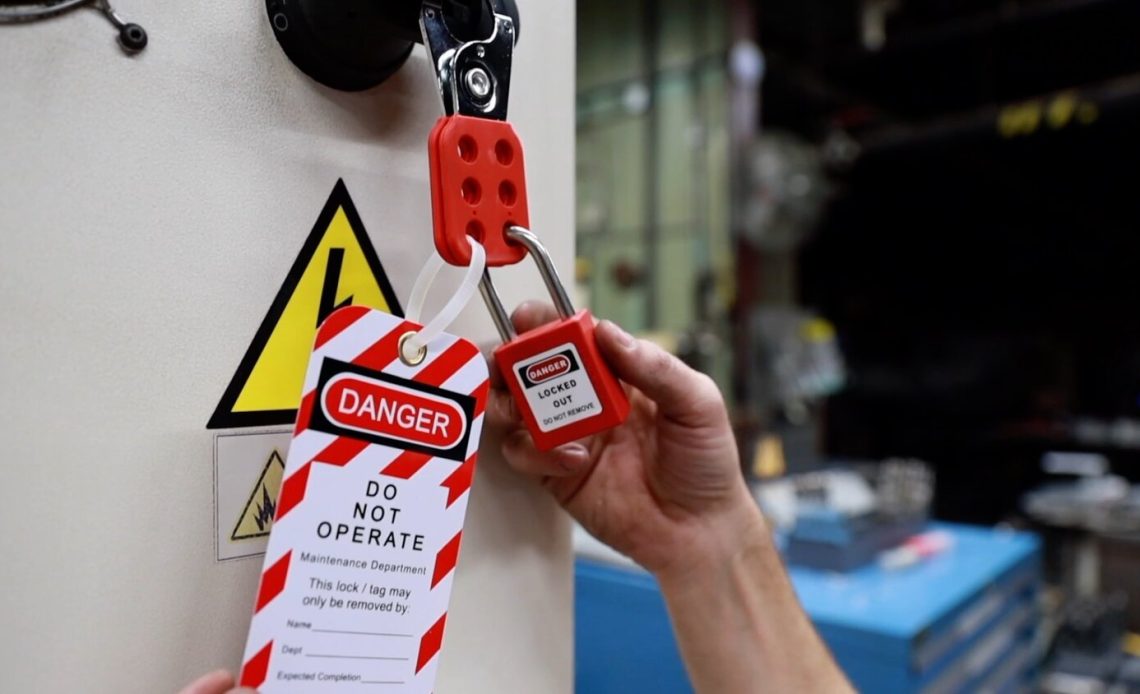Introduction
Safety should be a top priority in every workplace, regardless of the industry. While various safety measures are implemented to protect workers potentially hazardous areas, there are specific procedures and systems that play a crucial role in facility safety and ensuring hazard control. Two such systems that are widely recognized and utilized are Lockout/Tagout (LOTO) systems and barrier systems. In this blog post, we will delve into the importance of LOTO and barrier systems in workplace safety, their key components, and how they contribute to preventing accidents and protecting workers from potential hazards.

Lockout/Tagout
-
Importance of Lockout/Tagout: a lockout/tagout system is a widely used method to ensure worker safety while performing maintenance or repair work on machinery or equipment. This ensures that the machinery or equipment cannot be turned on accidentally while maintenance or repair work is being performed.
-
Steps involved in the lockout/tagout system: The lockout/tagout process involves several steps. First, the worker must identify the machinery or equipment to be serviced and identify all energy sources that need to be isolated. Next, the worker must shut off the energy sources and place lockout devices on them. Finally, the worker must test the machinery or equipment to ensure that all energy sources have been effectively isolated and the machinery or equipment cannot be turned on.
-
Effectiveness of lockout/tagout in hazard control: Lockout/Tagout is an effective method of hazard control because it ensures that workers are protected from the release of hazardous energy while performing maintenance or repair work.
-
OSHA requirements for lockout/tagout procedures: The Occupational Safety and Health Administration (OSHA) requires employers to implement lockout/tagout procedures in their workplace to avoid serious injuries or fatalities.

Barrier Systems
-
Role of barrier systems in hazard control: Barrier systems are another effective method of hazard control. Barrier systems are physical barriers that prevent workers from coming into contact with hazardous machinery or equipment.
-
Types and materials used in barrier systems: These barriers can be permanent or temporary and can be made from a variety of materials, including steel, plastic, or wire mesh.
-
Preventing contact with hazardous machinery or equipment: Barrier systems are effective because they physically prevent workers from coming into contact with hazardous machinery or equipment. This eliminates the possibility of accidental injury or death.
-
Unauthorized access prevention: Barrier systems can also be used to prevent unauthorized access to hazardous areas.
Implementing Lockout/Tagout and Barrier Systems
Employers must take all necessary precautions to ensure the safety of their employees. This includes implementing the lockout/tagout device and/or barrier systems where necessary. The following steps can be taken to implement lockout/tagout and barrier systems in the workplace:
-
Develop policies and procedures: Employers should develop policies and procedures for lockout/tagout and barrier systems. These policies and procedures should be communicated to all employees and should be updated as necessary.
-
Train employees: Employers should provide training to all employees on the proper use of lockout/tagout and barrier systems. This training should be ongoing and should be updated as necessary.
-
Conduct regular inspections: Employers should conduct regular inspections of lockout/tagout and barrier systems to ensure that they are functioning properly.
-
Evaluate effectiveness: Employers should evaluate the effectiveness of their lockout/tagout and barrier systems on a regular basis. This evaluation should include an analysis of any incidents that have occurred and any changes in equipment or processes that may affect the effectiveness of the systems.
Get your lockout training Booklets and video program here!

Difference Between Lock Out and Tag Out?
Lockout refers to the physical isolation of energy sources to prevent the accidental or unauthorized start-up of machinery or equipment. It involves the use of lockout devices such as padlocks, hasps, chains, or other similar mechanisms to immobilize the energy-isolating devices (e.g., switches, valves, breakers) in the off or safe position. By locking out the stored energy source, it ensures that the machinery or equipment cannot be powered on or operated.
Lockout procedures typically involve the following steps:
-
Preparation: Identify the energy sources, equipment, and isolation points.
-
Shutdown: Follow the proper procedures to shut down the machinery or equipment.
-
Isolation: Physically isolate the energy sources using lockout devices.
-
Verification: Confirm that the energy sources are effectively locked out and cannot be reactivated.
-
Maintenance or repair work: Perform the necessary tasks while the equipment is in a locked-out state.
-
Restoration: Once the work is completed, remove the lockout devices and verify that the equipment is in a safe condition before restoring power.
Tagout is a safety procedure that uses warning tags or labels to provide information about the status of the equipment or machinery being serviced. It involves attaching a tag or label to the energy-isolating mechanical device used, indicating that it must not be operated or energized because maintenance or repair work is being performed.
Tagout procedures typically involve the following steps:
-
Preparation: Identify the energy sources, equipment, and isolation points.
-
Shutdown: Follow the proper procedures to shut down the machinery or equipment.
-
Isolation: Disable the equipment by using the energy-isolating device and attach a tag or label to it.
-
Verification: Confirm that the energy sources are effectively tagged and that the equipment cannot be reactivated.
-
Maintenance or repair work: Perform the necessary tasks while the equipment is tagged out.
-
Restoration: Once the work is completed, remove the tag or label and verify that the equipment is in a safe condition before restoring power.

The Importance of Lockout/Tagout and Barrier Systems in the Workplace
Workplace safety is of utmost importance to employers and employees. The Occupational Safety and Health Administration (OSHA) is responsible for ensuring that workplaces are safe and healthy for all employees. OSHA regulations require employers to implement hazard control measures to protect workers from accidents that could result in serious injuries or fatalities. Two effective methods of hazard control are lockout/tagout and barrier systems.
Conclusion
In the pursuit of maintaining a safe work environment for affected employees, it is crucial to implement robust hazard control measures. Lockout/Tagout (LOTO) and barrier systems are integral components of workplace safety, helping to prevent accidents, injuries, and fatalities. By adhering to LOTO procedures and integrating barrier systems, employers and employees can work together to create a culture of safety, where the risks associated with hazardous energy sources are effectively mitigated. By prioritizing safety through the implementation of LOTO and barrier systems, organizations can protect their most valuable asset—their employees—and foster a culture of safety that permeates every aspect of the workplace.
OSHA Lockout Tagout Standard
The OSHA Lockout/Tagout (LOTO) standard, also known as 29 CFR 1910.147, is a regulation established by the Occupational Safety and Health Administration (OSHA) in the United States. The purpose of the Lockout/Tagout standard is to prevent accidental startup or energization of equipment that may endanger workers. It applies to all types of industries where such equipment components and machinery are used, including manufacturing, construction, and general industry.
Frequently Asked About Lockout/Tagout and Barrier Systems
Q: What is a Lockout Device?
A: Lockout devices come in various forms, depending on the type of energy source being controlled. Examples of lockout devices include lockout hasps, valve lockouts, circuit breaker lockouts, plug lockouts, and pneumatic lockout devices. These devices are typically made of durable materials such as metal or strong plastics to withstand industrial environments.
Q: What is a Tagout Device?
A: A tagout device is a tag or label that is affixed to a locked-out energy isolation point or control mechanism. It is usually made of a durable material such as plastic or laminated cardstock and is designed to be highly visible. The tag typically carries important information, such as the name of the authorized person who applied the lockout, the date of application, and a warning message indicating that the equipment is locked out and should not be operated.
Q: What is a LOTO Box?
A: The LOTO box serves as a central location for storing lockout devices, tagout devices, and keys, ensuring that all necessary equipment is readily accessible and organized. It is typically a durable and lockable container made of metal or sturdy plastic. The box is designed to accommodate multiple locks and tags, allowing authorized personnel to secure and control access to energy sources during maintenance operations.
Sources
https://www.osha.gov/etools/lockout-tagout
https://www.envirosafetyproducts.com/facility-safety-equipment/lockout-tagout.html?cat=6620
https://www.envirosafetyproducts.com/facility-safety-equipment/lockout-tagout.html?cat=6621




